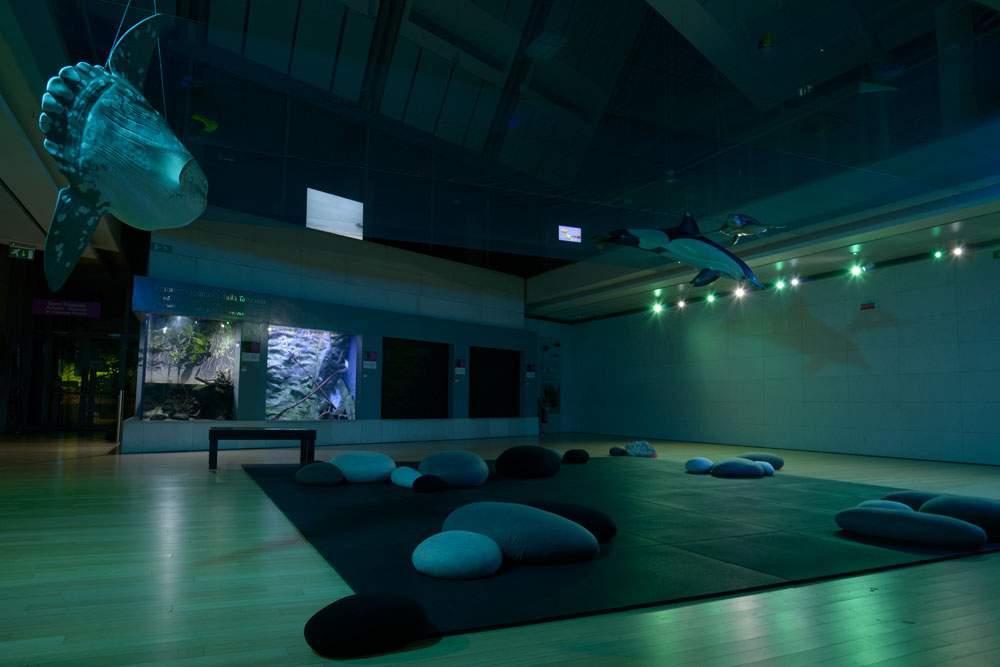On the occasion of World Environment Day, on Friday, June 5, at 6 p.m., MUSE - Museo delle Scienze will broadcast live on Facebook from @musetrento themultimedia installation Nautilus, a work created last February by Valentina Furlan in the temporary exhibition space of MUSE, inside which performer Mara Oscar Cassiani will perform. Two young artists who have established themselves through the visionary languages of electronic music and contemporary art.
It will be an immersive performance, preceded by a video interview with MUSE director Michele Lanzinger, which aims to highlight the problem ofplastic pollution in the seas and highlight the complex interactions between humanity, culture and nature.
The idea is to create a dystopian journey among the deep sea: Mara Oscar Cassiani’s console will be mounted at the center of Nautilus. The work, named after the legendary submarine led by Captain Nemo in Jules Verne’s Twenty Thousand Leagues Under the Sea, is the ideal setting to raise a planetary urgency: an underwater world, made thanks to recycled plastic collected by school children in Trentino, in which the living organism coexists with inorganic plastic matter.
The unprecedented performance art Underwater Club. Fauna and Oceans of 2020 is part of the initiatives of the Life Beyond Plastic project: the project is promoted by Istituto Oikos, a nonprofit organization committed to the protection of biodiversity and the dissemination of more sustainable lifestyles. In line with Goal 14 of Agenda 2030 Life Under Water, Life Beyond Plastic was created to engage and raise awareness of the problem of plastic pollution.
The Reggio Emilia Civic Museums are also participating in World Environment Day, offering a reflection on the environment andman’s impact on nature through museum collections. It is possible to dwell on the Chierici Museum’s worked flints to reason about the prehistoric lithic industry and make connections with present-day mining and quarrying, or on Copper Age burials to think about the role of metals in human history.
Native American artifacts become a tool to tell the story of man’s respect for nature.
The zoological collections help to think about the concept of science and how it has changed over the centuries, from the necessary pioneering experiments on amphibians and reptiles by Abbot Spallanzani and of which traces are still preserved in the collection that bears his name, to Baron Franchetti’s hunting trophies, restored to science in the early 20th century, in the Reggio Emilia museum.
As for the birth and development ofagriculture, the centuriation and transformation of the land through the great works of deforestation and reclamation during the Roman period are the basis of a climax whose apex is the devastation of the Amazon rainforest being perpetrated in South America.
Among the pictorial collections, the analysis of paintings by Reggio artists of the nineteenth century allows us to reconstruct the lifestyles of a society bound to the almost unspoiled natural landscape and the fruits of its land; those of the twentieth century, on the other hand, allow us to investigate the wise practices of Emilian agriculture, still intimately linked to the necessary respect for the land, always exploited in a sustainable way, among rows of vines and farmyard animals. It is precisely among the domestic animals housed in the zoology room that one can address the complex relationship of animal husbandry, which from an invention that arose as a result of agricultural development becomes nowadays a practice that is all too often intensive, diminishing the numbers of animal biodiversity on par with plant biodiversity only for the profit associated with increased productivity.
The most significant finds to speak of the damage that humans, through all forms of oil-related pollution, are doing to the environment are paradoxically the oldest: fossils millions and millions of years old that were formed over very long periods of time and are very quickly being depleted in the earth’s subsurface
Image: Valentina Furlan, Nautilus. Ph.Credit MUSE
 |
| Museums participate in World Environment Day: initiatives and collections to reflect on human impact on nature |
Warning: the translation into English of the original Italian article was created using automatic tools. We undertake to review all articles, but we do not guarantee the total absence of inaccuracies in the translation due to the program. You can find the original by clicking on the ITA button. If you find any mistake,please contact us.